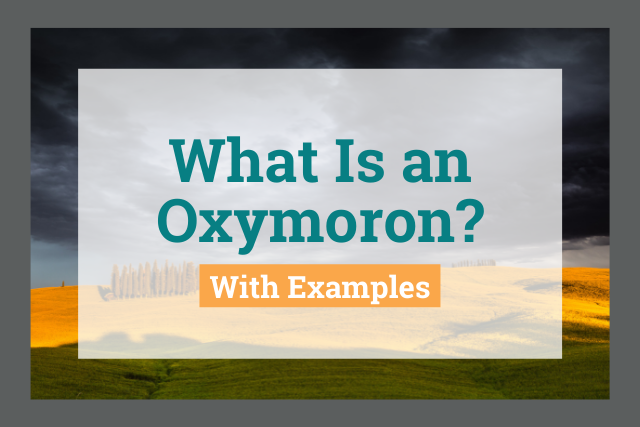
Do you know what an oxymoron is? No, it's not an insult!
An oxymoron is a common rhetorical device that combines two or more words with contradictory meanings into a single phrase.
They appear in literature and pop culture, and you probably use them all the time in your day-to-day life.
Today, we are taking a deep dive into the definition of this literary device. We'll also take a look at many fun and often funny examples of oxymorons.
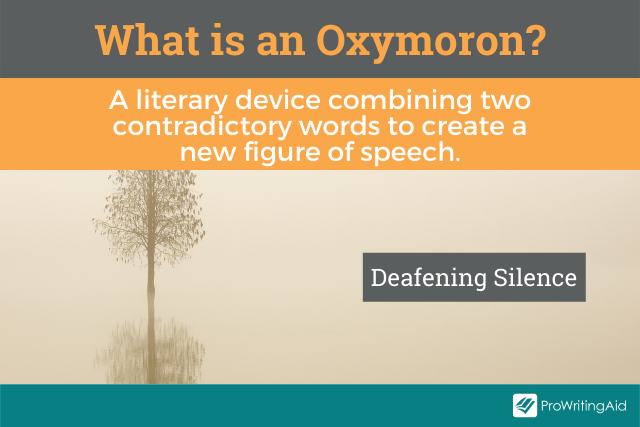
- What Is an Oxymoron?
- What Are Examples of Oxymorons?
- What's the Difference Between Oxymoron and Paradox?
- What's the Difference Between Oxymoron and Irony?
- What's the Difference Between Oxymoron and Antithesis?
- What Are Some Examples of Oxymorons in Literature?
- What Are Some Examples of Oxymorons in Pop Culture?
What Is an Oxymoron?
An oxymoron is a combination of words, typically just two words, with contradictory meanings. Even though the two words are often antonyms (words with opposite meanings), they don't negate each other.
However, if you think too hard about the meaning, you'll realize that on the surface it doesn't quite make sense.
When these words are combined, they create a figure of speech with a whole new meaning.
The word oxymoron is derived from a late-Greek word. In Greek, oxys means sharp or keen, and moros means foolish or dull. Together, oxymoros meant "pointedly foolish".
Now that we know the definition of oxymoron, let's take a look at some examples.
What Are Examples of Oxymorons?
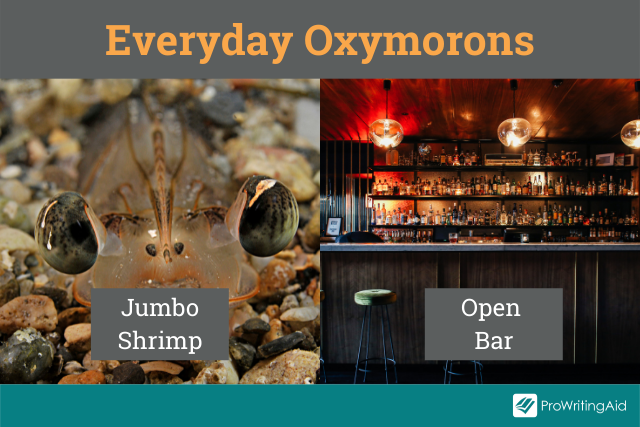
There are many oxymoron examples that you might come across in your everyday life. If you enjoy seafood, you might have tried jumbo shrimp.
Shrimp means small and jumbo means large, but when they are combined, this oxymoron just refers to larger-than-average shrimp.
When you order your jumbo shrimp, you might hope that there is an open bar.
This oxymoron means unlimited free drinks, but, by definition, a bar keeps something closed off—the opposite of open.
Have you ever played on an Oculus Rift? It's a virtual reality system.
Virtual reality is an oxymoron because "virtual" implies that something isn't real, but reality implies that it is. Together, these words mean a very realistic virtual world.

An elderly woman might talk about her adult children who live in a mobile home.
If you're in school to become an educator, you might have to spend a semester as a student teacher.
Or if you would prefer to get your master's degree, you'll be a graduate student.
My high school mascot was a stallion, so our female athletes were called the Lady Stallions. If you didn't know, a stallion refers to a male horse.
You might eat vegan bacon and fresh frozen fruit when you take a working vacation. Just try not to get freezer burn.
Even if you're a wise fool you can show real potential.
Maybe you've told a joke only to get deafening silence in response.
You'll also find examples in history and current events. You'll have definitely heard some in everyday conversation.
Countries engage in civil war or fight holy wars to defend those with blue blood.
On the nightly news, you might hear about an escaped prisoner or a controversy with a foreign national.
Perhaps a soldier was killed by friendly fire. Some of the stories might even be old news!
As a kid, you might have attended a slumber party where you played practical jokes on your friends.
You probably tried to act natural so no one would know what you were up to. We just hope you were never an uninvited guest!
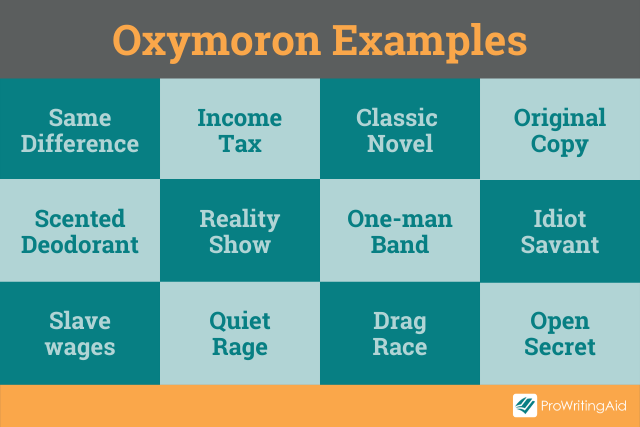
As you can see, there are tons of oxymorons in our lexicon. Here are a few more for your list:
- Same difference
- Terrible beauty
- Only choice
- Honest thief
- Silent scream
- Minor crisis
- Small crowd
Can you think of any other examples?
Do Oxymoron and Cliché Mean the Same?
Many oxymorons are so commonly used that they have become cliché. However, oxymorons themselves are not automatically clichés.
While they can be effective if used intentionally, clichés can make your writing feel stale and unimaginative.
ProWritingAid's Cliché check can help you identify them as they are easily overlooked.
In the below example, perhaps I could have said "aristocrats" or "high born", which both convey an identical meaning without being clichéd.

Try the Cliché Report with a free ProWritingAid account.
What Is an Oxymoron in Literature?
Oxymorons are often used in literature. As a literary device they can serve many functions. They can be used for emphasis, dramatic effect, or to highlight irony.
An oxymoron can confuse a reader intentionally, or paradoxically, it can offer clarity. It can be used for serious poignancy or for humor.
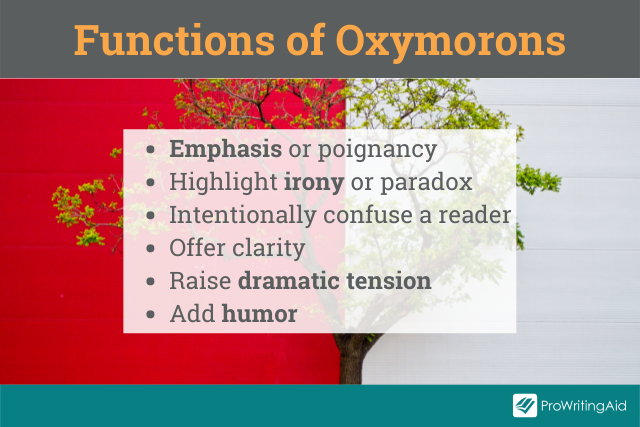
In short, an oxymoron is a versatile literary device. However, it's easily confused with other devices that involve contrast or contradiction.
What's the Difference Between Oxymoron and Paradox?
An oxymoron uses opposing or contradictory terms to create a figure of speech.
A paradox is when two contrasting ideas are put together for the purposes of creating a comparison. At first, a paradox may not make sense, but it causes deeper reflection.
An example of a paradox in literature is from George Orwell's Animal Farm.
The quote "All animals are equal, but some animals are more equal than others" might appear true at first, but nothing can be more equal than something else.
It causes the reader to really think about the nature of equality.
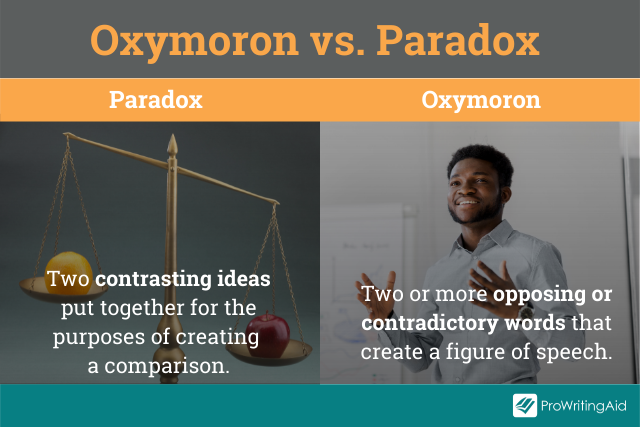
What's the Difference Between Oxymoron and Irony?
Irony is the difference between what a reader thinks should happen in a situation versus what is actually happening.
It plays with readers' expectations to demonstrate themes or build tension.
You might use an oxymoron to highlight irony, but irony isn't specifically related to a combination of words. It can also be more situational.
An example of dramatic irony comes from the play Oedipus Rex. Oedipus curses his father's killer, but he is unaware that he is actually his father's killer and has cursed himself.
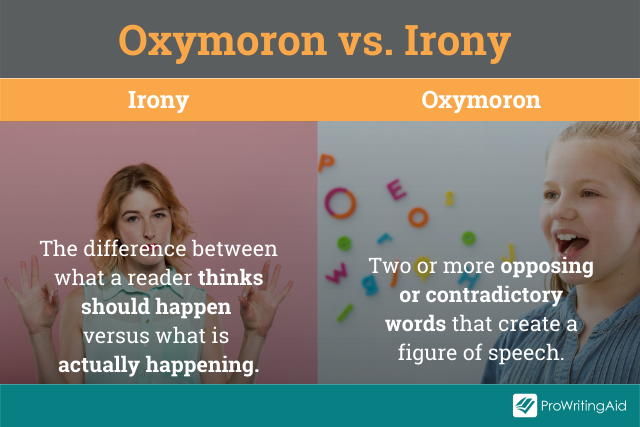
What's the Difference Between Oxymoron and Antithesis?
An antithesis also uses opposing words or phrases like an oxymoron, but it plays with syntax to create emphasis on an idea.
Antithesis isn't just one phrase. It uses parallel structure in conjunction with opposing or unrelated words.
William Shakespeare uses antithesis in this quote from Hamlet: "Give every man thine ear, but few thy voice; take each man's censure, but reserve thy judgment."
Each line uses parallel structure and contrasting ideas.

What Are Some Examples of Oxymorons in Literature?
Oxymoron is used frequently in literature because it can serve so many functions. In fact, certain literary genres are oxymorons themselves.
Science fiction, magical realism, and historical fiction are all oxymoronic. These phrases combine to create a whole new concept.
Shakespeare was a master of using oxymoron in his plays and poems. There are several examples in Romeo and Juliet, like the following quotes.
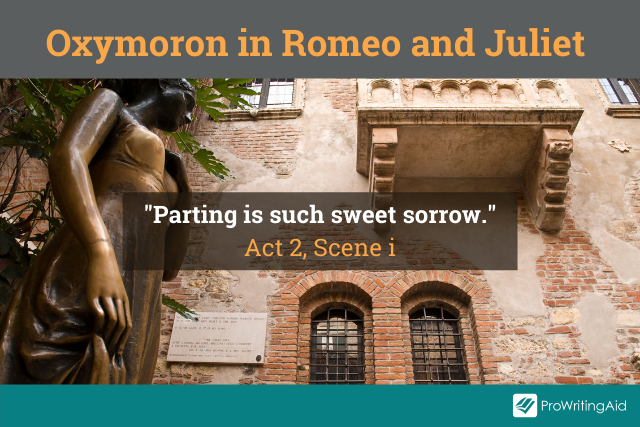
"Parting is such sweet sorrow." Sorrow and sweet, while not directly antonyms, are contradictory in their connotations.
Here's a longer passage from the famous tragedy that uses multiple examples of oxymoron:
"Why, then, O brawling love! O loving hate!
O anything, of nothing first create!
O heavy lightness! Serious vanity!
Mis-shapen chaos of well-seeming forms!
Feather of lead, bright smoke, cold fire, sick health!
Still-waking sleep, that is not what it is!
This love feel I, that feel no love in this."
In Animal Farm, George Orwell uses an oxymoron in the midst of a paradox: "All animals are equal, but some animals are more equal than others."
By definition, it is impossible for something to be more equal than another because equal means the same.
Alfred, Lord Tennyson uses three examples of oxymoron in one sentence in Idylls of the King. Here's the famous quote about Lancelot:
"His honour rooted in dishonour stood, And faith unfaithful kept him falsely true."
It illustrates his dilemma in the story. To be loyal to King Arthur, his friend, he must betray his love Guinevere, or vice versa.
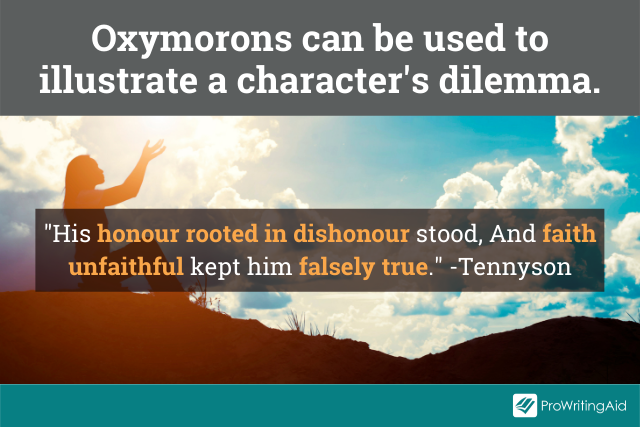
In Charlotte Brontë's classic Jane Eyre, St. John describes his love Rosamond as "delicious poison".
Like the Tennyson example above, this oxymoron highlights St. John's dilemma in choosing between love and honor.
In Fairies and the Quest for Never Land, Gail Carson Levine describes the character Vidia as a "loyal traitor".
Oxymorons aren't just for classic literature. Keep reading for some more modern examples.
What Are Some Examples of Oxymorons in Pop Culture?
Artist Andy Warhol once described himself as a deeply superficial person. Technically, one cannot be deep and superficial, as these words are opposites.
There are plenty of other oxymoron examples in pop culture. The book and HBO hit series Big Little Lies has an oxymoron right in its title. There is a book by Kirker Butler called Pretty Ugly.
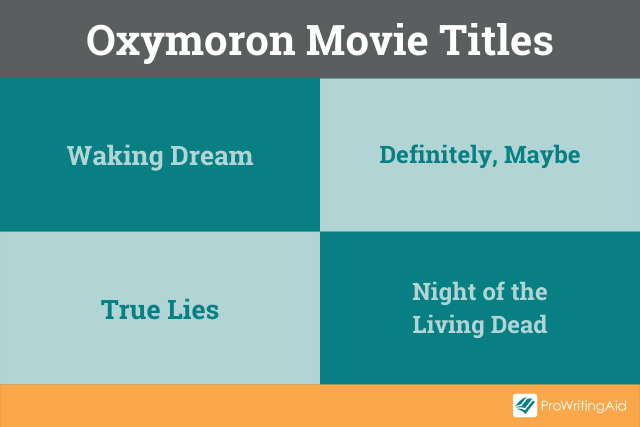
In 2018, a documentary about undocumented immigrants in the United States came out. It was called Waking Dream.
Hollywood hits Night of the Living Dead, True Lies, and Definitely, Maybe are all examples of oxymoron.
The John Legend song "All of Me" has a catchy verse with an oxymoron:
"All of me loves all of you
All your curves and all your edges
All your perfect imperfections."
Nineties kids might remember the oxymoronic (and often outright moronic!) show CatDog.
Those same kids might have grown up to listen to Fall Out Boy's song "Alone Together" or Kelly Clarkson's "Beautiful Disaster".
Their parents probably preferred Simon and Garfunkel's "The Sound of Silence" or the Beatles' "Hard Day's Night".
In fact, the Simon and Garfunkel classic contains some powerful oxymorons in its lyrics:
"People talking without listening
People listening without hearing"
These are just a few oxymoron examples from pop culture. Listen for more examples from your music playlists or Netflix queue.
Dear reader, parting is such sweet sorrow, but hopefully now you understand how oxymorons take opposing words and turn them into new figures of speech.
From William Shakespeare to Fall Out Boy, you can see just how versatile oxymoron is as a literary device. Can you think of any more fun examples?


